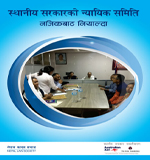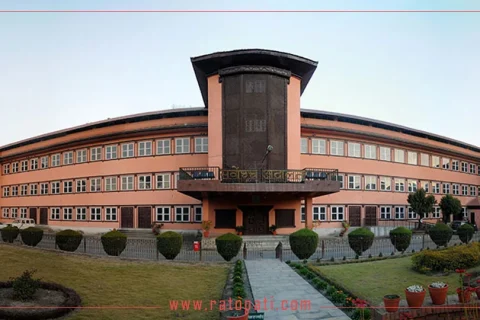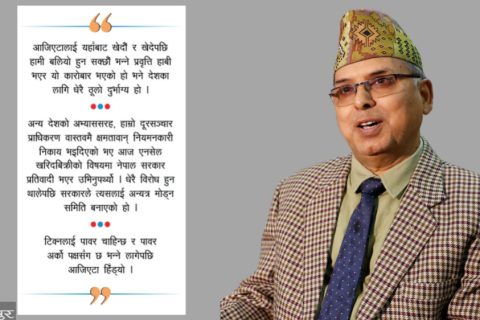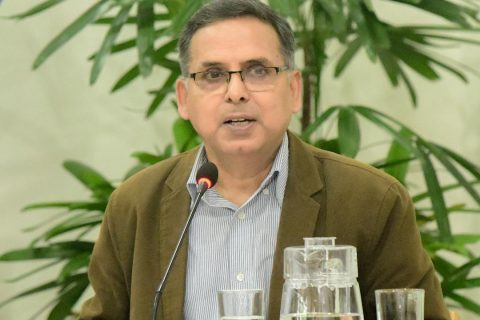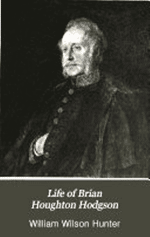
W. W. Hunter, Life of Brian Houghton Hodgson (London: John Murray, 1896)
Diplomacy is the art and practice of conducting negotiations between representatives of state in the interest of one’s own country. Brian H. Hodgson [1801-1894], who served in Nepal as British resident for many years, was probably the most renowned among all the foreign diplomats, who served Nepal hitherto with utmost dignity. However, Hodgson was not just a high caliber diplomat.
There was more to him than just diplomacy in the post Anglo Nepal War [1814-16]. The book Life of Brian Houghton Hodgson (London: John Murray, 1896) by W. W. Hunter, which was published after two years of his death, is an effort to trace him out in his entirety. It also gives analysis of his references on Nepal ever since he got the opportunity to go to Kumaun during 1819-1820 as a British Indian civil servant.Hunter studied the life and achievement of Hodgson dividing his early years in Nepal during 1820-1824, his further stay here as an assistant resident during 1825-1833, the stay in the capacity of resident during 1833-1839, and the last four years of his residenceship in 1839-1843. The book also explains his recluse in Darjilung following his return from Nepal.
The range of topics included in the book makes it clear that Hodgson was not only a diplomat, but also a scholar of diverse taste. His study on hill races of Nepal and the Himalayas, his advocacy for vernacular education in India and his contribution as a naturalist of the highlands have been separately identified and discussed in this book. He researched on numerous species of birds and mammals of Nepal and the Himalayas. Some of the species and genera of mammals and birds already bear his name. In the botanical context, he is remembered by the genus Hodgsonia heteroclita and by the beautiful rhododendron which Joseph Hooker dedicated to him. His writings on Buddhism, linguistics and religion have also been highlighted in the book. It provides a coherent analysis of the issues covered.
There is no doubt that Hodgson was the first foreigner in Nepal who assembled and studied local sources to write about the country in many key areas. He was not writing as a tourist or a short term visitor to Kathmandu. The book of Hunter lists many unpublished Sanskrit manuscripts and Tibetan printed books which Hodgson had collected, the unpublished manuscripts on Nepal, the list of his Buddhist, ethnological, and miscellaneous writings and books, his zoological writings and drawings with list of new genera and species first described by him. A large number of Nepalese materials, manuscripts and zoological specimens and drawings were sent by him to the libraries and museums of England and the European continent. Suffice it to say, some of the history of Nepal could not have been written without his references. Almost all historians who wrote on Nepal after him have relied on his materials and line of interpretation in the analysis of Nepal’s history. Even the illustrations of the sketch of Nepal residency and Prime Minister Bhim Sen Thapa are copied by many others after Hodgson.
Hunter’s book has many references of Hodgson’s views on Gurkhas. In his opinion, subsequent to their invasion of the Kumaun hills in 1790, Gurkhas were not taken well in Kumaun because of their style of governance, confiscation and squeezes. Hodgson who visited Kumaun before he got some experience in Nepal describes the 24 years of Nepal rule on Kumaun as oppressive. Describing this situation later, he notes that “no sooner had the British forces entered the hills (in 1815) than the inhabitants began to join our camp, and bring in supplies of provisions for the troops.” According to him, “their [Nepalese] tyranny has passed into a proverb, and at the present time, when a native of these hills wishes to protest in the strongest language in his power against some oppression to which he has been subjected, he exclaims that for him the Company’s rule has ceased, and that of the Gurkhas has been restored.” Once the British took over, changes were introduced but for a time indeed it seemed that, under Gurkha rule, the only alternative for the Kumaun hill-men lay between flight to the jungles and the sale of themselves and their women and children into slavery on the Indian plains.
As the book notes, based on Hodgson’s writings, the Gurkha administration in Kumaun squeezed the last drop out of the local people. It is stated that the exactions of the revenue officials and soldiers in the Garhwal district were “so heavy that even the Gurkha military chiefs found it impossible to enforce them.” The local cultivators “who remained [following depopulation] were responsible for making good the whole revenue.” But the depopulation under the Gurkha oppressions had rendered it impossible for the taskmasters to wring the full demand out of the remaining inhabitants. However, according to Hodgson, fiscal brutalities and depopulation kept pace together and the revenue balances under the Gurkhas annually increased compounding the misery of the local habitants. Some exaggeration in Hodgson’s descriptions could be sensed at this stage.
It is clear to Hodgson that both Britain and Nepal were watching each other, making no progress in bilateral relationship. They appeared “equally incapable as an opponent and as an ally” in the first twenty-five years of their intercourse. The treaty signed between these two countries in 1792 remained a dead instrument. It is stated that “the Nepalese encroached on our frontier, and a new treaty in 1801 ended in our further discomfiture.” Captain Knox who was appointed as a British representative in Kathmandu was compelled to withdraw in 1803. There was a break in the diplomatic tie. It was accepted that the British involved themselves in domestic disputes of the reigning family in Nepal.
Further, Prime Minister Bhim Sen Thapa was not an easy person to deal with. The 1914-1816 war was a big lesson to him in the opinion of Hodgson. It convinced him, “once and for ever, as to the reality of the British power – “a power that crushed thrones like potsherds.” Following this, the terms of peace were negotiated. However, Lord Hastings, who understood the situation, insisted that Nepal give up Terai as the price of truce. It was his thinking that this alone can effectually curb Nepal which had developed expansionist attitude. Terai meant the riches of the country. It also “furnished it with the sinews of war, was the lush, unhealthy borderland at the foot of the hills.” Moreover, “It was precisely because Lord Hastings knew that the loss of the Tarai would disable Nepal for further aggressions that he determined to have it.” notes Hodgson.
The truce was indeed aweful for Nepal. However, what is more interesting is the guile demonstrated by the then Prime Minister Bhimsen Thapa. It is noted that Bhimsen “first, by skilful diplomacy, obtained a retrocession of part of the eastern Tarai as a special favour from Lord Hastings to the young Raja [of Nepal], and in return for relieving us of certain pecuniary obligations. He then, by even more skilful obstructions, endeavoured to render nugatory our demarcation of the frontier. By 1819 these delays amounted to a contumacious disregard of the treaty, and nearly led to chastisement by a British force. Bhim Sen next changed his tactics from open obstruction to covert frustration. Boundary pillars were erected, but unsurveyed gaps were left for future encroachments, and for endless annoyance to the British officers. The rugged hills and dense jungles, in the absence of a scientific survey, favoured uncertainty. Dr. Oldfield states that the boundary between Nepal and Oudh was not finally adjusted until 1830, and that between Nepal and the British territories not for some years later.”
The improving relationship between Nepal and the British government owed much to the effort of Brian H. Hodgson. Living in Kathmandu for many years, he established himself “as a man of ascetic life, deeply versed in divine things.” His knowledge on Buddhism, the friendship with Tibetan Grand Lama, search for Sanskrit manuscripts and his transcriptions of Hindu texts, etc made him popular. Following some illness, he even adopted Brahmanic food and drink habits – saying no to meats or wines, “the Hermit of the Himalayas.” They all had influence on the locals. All this helped in building relations.
Hodgson wanted to complete the collection of materials to write a book on the history of Nepal. In 1857, he wrote to his wife, asking her to “speak most despondently of my father’s state [who was not in good health in England], and of the ardent hopes he has of my speedy presence. So I must cast away my long-cherished ambition of writing that History of Nepal for which 1 have been collecting materials during half my life, and hasten to do my duty to those most dear to me. I shall hardly have a month at Darjiling, and must then hurry down to Calcutta to prepare for my voyage.”
As Hunter shows, Hodgson lived as a remarkable diplomat. He lived for 95 years. His contribution to the Himalayan studies have been pioneering. In fact, the 2004 book of David M. Waterhouse, which was published after 110 years of Hodgson’s death, explains so well what his contribution means in the modern context. It is no doubt great.
The first paragraph of W. W. Hunter in Chapter I of his book aptly states: “Had [Hodgson] died seventy years previously, he would have been mourned as the most brilliant young scholar whom the [British] Indian Civil Service has produced. Had he died in middle life, he would have been remembered as the masterly diplomatist who held quiet the kingdom of Nepal and the warlike Himalayan races throughout the disasters of the Afghan war. Had he died at three-score years of age, he would have been honoured as the munificent Englishman who enriched the museums of Europe with his collections, enlarged the old boundaries of more than one science, and opened up a new field of original research.” In this regard, Hunter’s introduction is not exaggerated at all.


